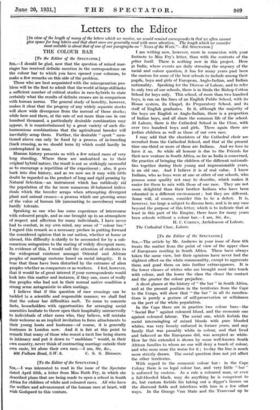Letters to the Editor
[In view of the length of many of the letters which we receive, we would remind correspondents that we often cannot give space for long tellers and that short ones are generally read with more attention. The length which we consider most suitable is about that of one of our paragraphs on " News of the Week."—Ed. SPECTATOR.] COLOUR. BAR [To the Editor of the SPECTATOR.] SIR,—I should be glad, now that the question of mixed mar- riages has received definite mention in the correspondence on the colour bar to which you have opened your columns, to
make a few remarks on this side of the problem. •
Those who are best acquainted with the miscegenation pro- blem will be the first to admit that the world at large still lacks a sufficient number of critical studies in race-hybrids to state certainly what the results of definite crosses are in comparison with human"normii. The general study" of heredity, however, makes it clear that the progeny of any widely separate stocks will show wide divergence from the normal of those stocks; while here and there, at the rate of not more than one in one hundred thousand, a particularly desirable combination may appear, it is counterbalanced by a great variety of such dis- harmonious combinations that the agricultural breeder will inevitably scrap them. Further, the desirable " sport " men- tioned above can only be fixed by a process of in-breeding (back crossing, as we should term it) which could hardly be contemplated in man Human history presents us with a few mixed races of very long standing. Where these are undoubted as to their original hybrid nature, the result is not so strikingly successful as to encourage a repetition of the experiment ; also, it goes back into dim history, and as we now see it may with little doubt be regarded as the product of long and rigid pruning by Natural Selection—an instrument which has ruthlessly, rid the population of the far more numerous ill-balanced indivi- duals which the breeder scraps when attempting divergent plant and animal crosses—a, process which our growing sense of the value of human life (amounting to sacredness) would hardly tolerate.
Speaking as one who has some experience of intercourse with coloured people, and as one brought up in an atmosphere of respect and affection for many individuals, I have never had to combat, in my own mind, any sense of " colour bar." I regard this remark as is necessary preface in putting forward the considered opinion that in our nation, whether at home or abroad, this difficulty is chiefly to be accounted for by a sub- conscious antagonism to the mating of widely divergent races. In evidence of this, I would call the attention of students to the widespread existence amongst Oriental and African peoples of marriage customs based on racial integrity. It is true that these have been disturbed by the entrance of alien peoples whether as conquerors or as workers. I feel, however, that it would be of great interest if your correspondents would look into this matter and instance, if they can, eases of really fine peoples who had not in their normal native condition a strong sense antagonistic to alien matings.
I believe that if this question of race crossings can be tackled In a scientific and responsible manner, we shall find that the colour bar difficulties melt. To come to concrete facts, householders with opportunities for arranging social amenities hesitate to throw open their hospitality unreservedly to individuals of other races who, they believe, will mistake their welcome as an implicit invitation to form attachments to their young hosts and hostesses—of course, it .is generally hostesses in London now. And it is fair at this point to remark that many of those who resent a tacit line being drawn in intimacy and put it down to " snobbism " would, in their own country, never think of contracting marriage outside their own caste, let alone their own race.—I am, Sir, &c.,










































 Previous page
Previous page